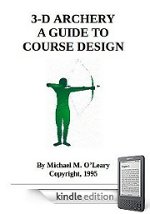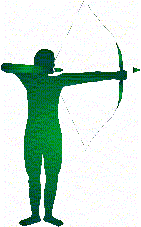3-D Archery
A Guide to Course Design
by Michael O'Leary
3-D Archery; A Guide to Course Design is now available through the Amazon Kindle Store.

Introduction

Recreational archery has the potential to be a dangerous sport. Bows and arrows are, by design, lethal. Archery ranges and 3-D courses designed when "fast" bows shot 200 feet per second may not be safe today. Arrows which miss targets may endanger other archers on the range, or may fly onto property which the archery club does not control. New and redesigned ranges must be prepared to handle today's "fast bows" shooting in excess of 300 feet per second.
I wonder when I speak to some archery club executives about range safety and discover incomplete or poor awareness of the possible dangers. The comments "You're not supposed to miss" and "Our course is designed for the unlimited [top] archer (implying that ‘our' shooters don't miss)" are surprising for their alarming indication that safety is often NOT a primary consideration in the design of archery ranges and courses.
The design of an archery range may be undertaken by any archer with a basic understanding of the fundamentals of safe design. Many years of shooting experience and/or a successful hunting record may help, but are certainly not necessary. 3-D Archery, A Guide to Course Construction can provide the guidance to a new course designer, and it can refresh the knowledge of the experienced designer to help assess and improve, or design from scratch, an archery course.
Michael M. O'Leary
Are Our Ranges Safe?
There are many 3-D and field archery courses in Canada. Some have existed for many years and others have been established recently. These ranges were designed to meet the shooting needs of the owning club at the time they were laid out, and were probably designed with some consideration for the equipment in use at the time they began.
Archery in Canada has a reputation as a safe sport. Whether this is as a result of good fortune or good range and course design is debatable. The higher velocities of newer archery equipment are sufficient cause for a critical re-examination of existing ranges and more careful consideration of the way we design, construct, and assess 3-D and field ranges.
I would like to introduce to you a new work which examines the requirements and possibilities for the design of safe archery ranges. 3-D Archery, A Guide to Course Construction, explores the requirements and possibilities for the archery course designer. Through his experiences as an archer and as an Army officer with extensive experience in the design of field ranges, Michael O'Leary has documented the necessary guidance for archers and clubs planning to lay out new ranges or update their existing courses.
A Guide to Course Construction
3-D Archery, A Guide to Course Construction examines the safety requirements for a single arrow missing the target, for these are the ones we must worry about. The Guide helps the designer understand the safety requirements created by arrow velocities, terrain effects and different shooting station and target situations. The Guide does not offer a magic formula or secret method that automatically shows anyone how to lay out an absolutely guaranteed safe archery range. The Guide takes the course designer through a comprehensive discussion of safe design considerations, helping the designer to systematically make consistent and reasoned design decisions.
3-D Archery, A Guide to Course Construction covers much more than range design safety. Other topics covered include: Assessing the Course Design Mapping the Course Course Signs and Symbols Putting the Course to Use The Range Officer's Briefing "The Shoots" Supplementary Issues; A Medical Plan, The Environment, Care of Property Assessment and Inspection Checklists.
Check this link to review the THE SHOOTING LANE INSPECTION CHECKLIST.
3-D Archery - A Guide to Course Design
- Cover Page
- Copyright Notice
- Table of Contents
- Foreword
- Chapter 1 - Arrow Ballistics; From Single Shot to Course Requirements
- Chapter 2 - The 3-D Course; Layout, Safety and Siting
- Chapter 3 - Mapping the Course
- Chapter 4 - Assessing the Course Design
- Chapter 5 - Features: Targets and Setting the Unique Shots
- Chapter 6 - Signs and Symbols
- Chapter 7 - Putting the Course to Use
- Chapter 8 - The Shoots
- Chapter 9 - Supplementary Issues; A Medical Plan, The Environment, Care of Property
- Annex A - FCA National Shoot Rules
- Annex B - Formulae and Tables
- Table I
- Table II
- Table III
- Annex C - Assessment and Inspection Checklist
About the Author
Michael O'Leary spent 26 years serving in the Canadian Army. Initially trained in 1983 at the Royal Canadian School of Infantry at Gagetown, NB, he has also had advanced training in heavy weapons (mortars), laser safety and the ground control of fighter aircraft. In a career which often focused on infantry training and field ranges, Michael has commanded infantry rifle and mortar platoons, and, during a tour with the Infantry School, instructed advanced training courses. From July 1996 to early 1999, he was employed as the Range Control Officer at the Land Force Central Training Centre Meaford in Ontario, Canada. His responsibilities there included firing range safety and design.
With a return to archery in 1991, Michael began to critically examine the ranges on which he shot (in Ontario and Nova Scotia), comparing the structure and conduct of the archery ranges with those he designed and ran as an infantry officer. His notes and observations collected over the past few years have led to the creation of 3-D Archery, A Guide to Course Design.
- The O'Leary Collection; Medals of The Royal Canadian Regiment.
- Researching Canadian Soldiers of the First World War
- Researching The Royal Canadian Regiment
- The RCR in the First World War
- Badges of The RCR
- The Senior Subaltern
- The Minute Book (blog)
- Rogue Papers
- Tactical Primers
- The Regimental Library
- Battle Honours
- Perpetuation of the CEF
- A Miscellany
- Quotes
- The Frontenac Times
- Site Map
QUICK LINKS
The Guide is now available through the Amazon Kindle Store.

NOTE: File downloads total 2.25 Mb.
Cover Page
Copyright Notice
Table of Contents
Foreword
Chapter 1
Chapter 2
Chapter 3
Chapter 4
Chapter 5
Chapter 6
Chapter 7
Chapter 8
Chapter 9
Annex A - Shoot Rules
Annex B - Formulae
Table I
Table II
Table III
Annex C - Inspection Checklist